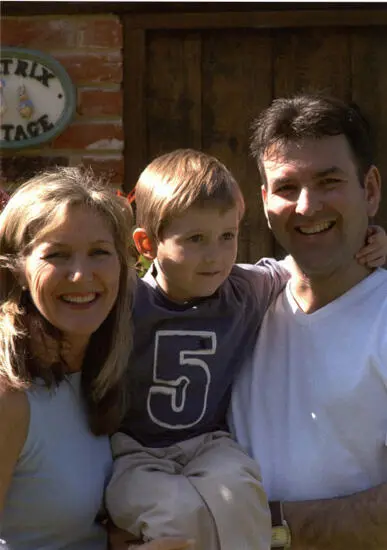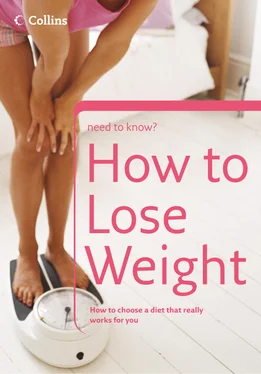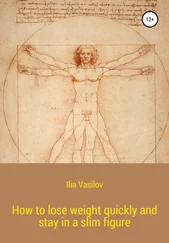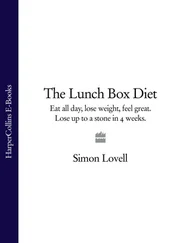There is now evidence that our environment can seriously damage our size. In 1955, fewer cars and more housework meant that the average woman could expend up to 800 calories a day more in activity than she does today. According to a recent survey, the average woman now weighs 65 kg (10 st 3.5 lb) and measures 38-34-40.5, but in 1951 she weighed 62 kg (9 st 10 lb) and she measured 37–27.5–39.
Family matters
A child with two obese parents has a 70 per cent chance of becoming obese, compared to 20 per cent for a child of two slim parents. That alone suggests strongly that our weight is predetermined by what we inherit from our parents. But how far is that inheritance down to genes, and how much is due to the family’s lifestyle? And if the link is genetic, which side of the energy equation are the inherited genes affecting?
Much of the current research into the link between genes and weight concerns the behaviour of individual genes and how they affect our appetite or the way we turn food into energy. There have been some exciting developments: for instance, it has been shown that in very rare cases, severe obesity is caused by a genetic mutation that causes the failure of a hormone called leptin, which regulates appetite in the brain. Children born without leptin will eat uncontrollably, but their appetite and weight will return to normal once they receive leptin injections.
Our caveman inheritance
Eventually, research into leptin deficiency and some other specific gene mutations may lead to effective treatments for what scientists now call ‘common obesity’. However, whereas only a very few people are unlucky enough to have faulty genes, none of us can escape the genetic pattern that has been handed down to us over millions of years.
Our earliest human ancestors evolved in an environment where food supplies were scarce and sporadic. Our strongest food preferences and cravings – for sweet, fatty and salty foods – are a reminder of the times when sources of glucose, essential fats and minerals were hard to come by. Energy conservation in time of famine was vital, so those human beings who had ‘thrifty genes’ –who were most able to convert food to fat and store it effectively – were the most likely to survive, breed and pass on those genes.
must know
Body shapes
Basic body shape is inherited and can only be modified, not completely changed, by diet and exercise. Typical body shapes are as follows:
 Endomorph (soft and rounded, with a higher than average percentage of body fat).
Endomorph (soft and rounded, with a higher than average percentage of body fat).
Mesomorph (well proportioned with a higher proportion of muscle to fat).
 Ectomorph (taller and narrower than average with lower than average body fat).
Ectomorph (taller and narrower than average with lower than average body fat).
Old genes, new environment
Unfortunately, the genetic make-up that suited us so well for survival in prehistoric times is very unhelpful today in our modern environment. Instead of eating fatty, sweet or salty foods only rarely, we now have access to them 24 hours a day, seven days a week, if we want. When we do eat excess fat and sugar, our ‘thrifty genes’ ensure that we store it very efficiently as fat. And instead of foraging and hunting to find our food, we only have to drive to the supermarket, pick up the phone or log on to the internet.
So how can a history lesson help us to lose weight? One vital thing it teaches us is that weight is not a moral issue. People do not put on weight because they are essentially greedy, lazy or sinful: on the contrary, gaining weight is the natural human response to life in a food-rich and activity-poor environment. If our ancestors had had the choice between hunting for their food or going to the supermarket, which one do you think they would have chosen?

From generation to generation, it’s hard for us to escape the genetic patterns that are handed down through the ages.
As we are discovering, the fact that our genes have not yet caught up with our environment is bad news for our health. So the other lesson that history teaches us is that, as we cannot change our genes, in order to stay slim and healthy we need to adapt our environment-with small changes to diet and lifestyle that can swing the energy balance back in our favour.
Metabolism
This is the process by which the body converts the food that we eat into everything it needs to function, and as such it plays a key role in regulating our weight. Between 20 and 30 per cent of the energy that our metabolism produces is spent on exercise, and between five and 10 per cent is used to digest our food. The remaining energy – which is between 60 and 75 per cent – is consumed as ‘resting metabolic expenditure’ (RME), and this can vary widely between individuals. Medical problems that can affect the metabolism include an under-active thyroid and, in very rare cases, conditions such as Prader-Willi Syndrome.

If you’re stressed, try to relax or have a massage rather than comfort eating.
People with weight problems often believe they have a slow metabolism, but in fact overweight people have a faster metabolism than average as they need to burn energy more efficiently to move a heavier body around. This explains why slimmers often find it hard to lose the last few pounds towards their target; with less weight to carry, the body requires slightly fewer calories to support the metabolic process and therefore their diet and exercise plan might need a slight adjustment. This does not mean though that dieting ‘damages’ the metabolism; it is a natural process that re-sets the body’s energy balance over time.
One major factor that influences your metabolic rate though is the amount of lean muscle tissue in your body, as lean tissue is a more efficient fuel-burner than fat. Becoming more active is a great way to boost your metabolism – exercise burns fat, and builds muscle, which burns fat more efficiently. . . a win–win situation for your body.
must know
Fast food
It’s official: fast food causes weight gain. A 15-year study in the US showed that people who ate at fast food restaurants more than twice a week gained an extra 4.5 kg (10 lb) compared to those who ate fast food less than once a week.
A NEAT trick
Scientists are also excited about the way that we move and use energy when we’re not consciously exercising: a process they call Non–Exercise Activity Thermogenesis (NEAT). Studies at the Mayo Clinic in Minnesota, USA, have shown that obese people expend fewer calories in all areas of daily life than slim people; they sit still for longer periods and even fidget less. Researchers estimate that slim people could ‘naturally’ burn up to 350 calories more per day in this way than overweight people – the equivalent of a 30–minute run. When slim volunteers were overfed so that they put on weight, their energy output remained the same, however, suggesting that the overweight people were not being lazy’: there is a bio–chemical process at work that predisposes them to be less active.
While it may take years to identify exactly how and why this happens, it is further evidence that making activity an everyday habit is key to losing weight and staying slim –wherever you start on the road from completely sedentary to fighting fit.
Читать дальше

 Endomorph (soft and rounded, with a higher than average percentage of body fat).
Endomorph (soft and rounded, with a higher than average percentage of body fat).












